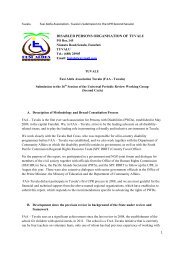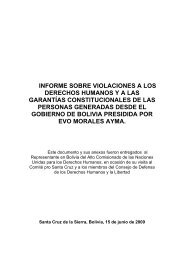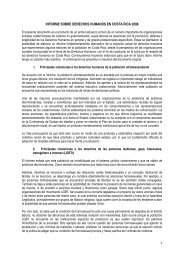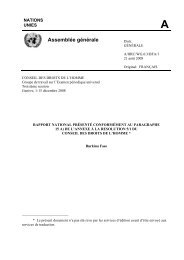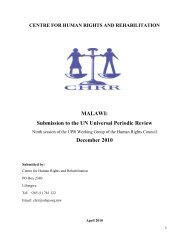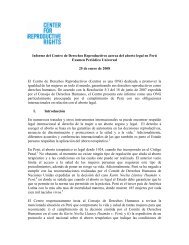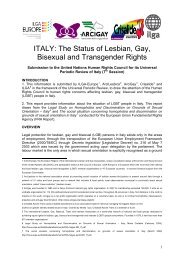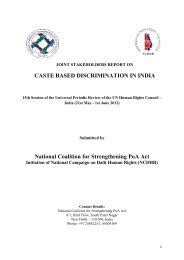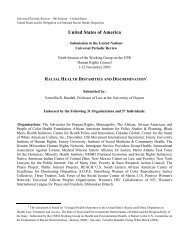Prison Needle Exchange: Lessons from a Comprehensive Review ...
Prison Needle Exchange: Lessons from a Comprehensive Review ...
Prison Needle Exchange: Lessons from a Comprehensive Review ...
You also want an ePaper? Increase the reach of your titles
YUMPU automatically turns print PDFs into web optimized ePapers that Google loves.
and in prisons; a history of the prison system’s response to HIV and HCV; a review of prison<br />
needle exchange programs, including historical information, evaluations, and lessons<br />
learned; the current situation; and future directions.<br />
Switzerland<br />
Summary<br />
Switzerland has approximately 150 prisons spread across the 26 cantons that comprise the<br />
Swiss federation. Although the penal code is federal, the administration of the prisons is the<br />
responsibility of the government of the canton in whose territory the<br />
institution is located. There are approximately 6000 prisoners in<br />
Switzerland. The largest prison has a population of 350, although<br />
the majority of prisoners are incarcerated in small institutions with<br />
fewer than 100 prisoners.<br />
In 1992 Switzerland became the first country to introduce a prison<br />
needle exchange program. The initial program was started on an<br />
informal basis by a physician at the Oberschöngrün men’s prison<br />
who, ignoring prison regulations, began distributing sterile syringes<br />
to patients who were known to inject drugs. In 1994 a formal needle exchange pilot project<br />
was established in the Hindelbank women’s prison. After a successful trial and evaluation at<br />
Hindelbank, needle exchange programs have been expanded to a total of seven Swiss prisons.<br />
In 1992 Switzerland became<br />
the first country to<br />
introduce a prison needle<br />
exchange program.<br />
HIV/AIDS, HCV, and IDU in Switzerland<br />
According to figures released by UNAIDS and the WHO in 2002, there are approximately<br />
19,000 adults (aged 15 to 49) in Switzerland living with HIV or AIDS. This represents an<br />
HIV prevalence rate in the general population of approximately 0.5%. The number of newly<br />
diagnosed HIV infections declined in Switzerland between 1992 and 2000. People who<br />
inject drugs comprised approximately 15% of positive HIV tests in 2000-2001. 122<br />
Swiss drug policy began moving toward harm reduction during the late 1980s. During this<br />
time, open injection drug scenes were a significant feature in cities such as Zurich and Berne.<br />
In <strong>Needle</strong> Park, as it was known, in the Letten district of Zurich, thousands of people who<br />
inject drugs congregated daily to openly purchase and inject heroin. <strong>Needle</strong> Park received<br />
international media attention and led the Swiss government to adopt significant harm-reduction<br />
programs, such as expanded needle exchange access, methadone and heroin maintenance,<br />
safe injection facilities, and community health services for drug users. These interventions<br />
successfully ended the open drug scenes and resulted in increased health benefits<br />
for users. 123<br />
HIV/AIDS, HCV, and IDU in Swiss prisons<br />
Switzerland has not undertaken extensive HIV/AIDS or HCV prevalence research in prisons.<br />
However, HIV infection rates have been estimated to be between 2% and 10%. 124 As<br />
early as 1985, blood testing among Swiss prisoners detected the presence of HTLV-III antibodies<br />
in some prisoners. 125 More recently, a 1999 report based on interviews with 234 prisoners<br />
at Realta prison found an HIV infection rate of 5.1%, a result acknowledged as being<br />
comparable to rates in other institutions. The same study found that approximately 9% of the<br />
prisoners injected drugs at the time of the study. 126<br />
20 <strong>Prison</strong> <strong>Needle</strong> <strong>Exchange</strong>: <strong>Lessons</strong> <strong>from</strong> a <strong>Comprehensive</strong> <strong>Review</strong> of International Evidence and Experience



